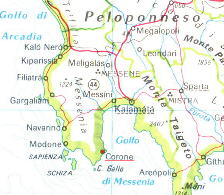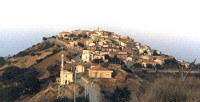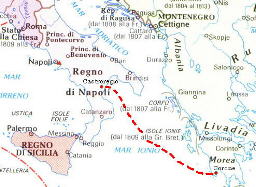 The
Ierovante
surname appears the first time in Italy in the 1534, year in which some
inhabitants of Corone, a small town sited in the Morea
region, in
Greece, took refuge to escape to the invasions of the Ottomen. Corone
was
in those days under the domination of the Albanian people; the
expansion
of the Turco Ottomano empire in the Greek region pushed some of the
family
more in sight of Corone to accept the refuge offer given by the
aragoneses,
which allowed to the greeks of install oneself in some locality of the
south of Italy, in particular in Calabria, where still today there are
numerous towns in which it is spoken it the ancient Greek language.
The
Ierovante
surname appears the first time in Italy in the 1534, year in which some
inhabitants of Corone, a small town sited in the Morea
region, in
Greece, took refuge to escape to the invasions of the Ottomen. Corone
was
in those days under the domination of the Albanian people; the
expansion
of the Turco Ottomano empire in the Greek region pushed some of the
family
more in sight of Corone to accept the refuge offer given by the
aragoneses,
which allowed to the greeks of install oneself in some locality of the
south of Italy, in particular in Calabria, where still today there are
numerous towns in which it is spoken it the ancient Greek language.
The country in Italy in which installed the Ierovante family is Castroregio, sited in Calabria, in the province of Cosenza. At present there are numerous family Ierovante scattered in the world; between the end of the 1800 and the first of the 1900 some inhabitants of Castroregio, between which also some Ierovante, emigrated and established in America (United States) and in Argentina; other one transferred in Germany and other still transferred by Castroregio remaining in Italy. Today the Ierovante are numerous and scattered in a lot of parts it of the world, but the origin is common, and comes from the town of Castroregio.
The historic situation in the 1460-1480 in the Greek -Albanian region
In Albania, in about
the 1460, get togheter in Alessio the “league of
all the Albanian
peoples”, that proclaimed as his head Giorgio Kastriota
Skanderberg. This
last, also with the help of Alfonso di Aragona, but with forces clearly
subordinates in number, defeated more time the Ottomen, which although
they had recourse to all the stratagems, didn't succeed to have reason
of the troops guided by Skanderberg. In 1461 outbreak in the kingdom of
Ferdinando di Aragona, success to Alphonso, the rebellion of the
barons.
Skanderberg lands in the south of Italy and soon the order is
re-established.
The
value of the
Albanian leader, that for about a period of thirty years maintains far
from the Europa the Ottoman threat, reveals splendidly in Croia in the
1465. It is the same sultan, Maometto II, that, tired of the continuum
defeats of his army, comes to besiege Croia, where Skanderberg and his
men are shut in. Yet, the sudden sorties of this last and the
ascertainment
that the undertaking is impossible, make the sultan to abandon the
siege.
But the death of Skanderberg, that happened during the meeting of the
league
to Alexis in the 1467, nearly sudden made fall the hope of a possible
further
opposition to the Ottoman empire and well soon nearly all the Albania
was
engaged.
A
lot of family
then, droping every thing and giving proof of big pride and national
dignity,
preferred to embark for Italy in order of don't give way to the
Ottomen.
They joined, then, in the south of Italy in the 1478, and were divided
and fixed up in some extent hamlets left uninhabited for the scourges
that
invested the Calabria during the sec. XV.
The foundation date of Castroregio
 Controversial
is the foundation date of Castroregio. According to A. Scura, this
would
go up again to the 1476-78 and together with Scura other people is of
the
same notice. Giorgio Toscano, in its ‘Storia di
Oriolo’ asserts that he
has seen in the file of the castle the assent privilege of the king,
which
authorized the building of a hamlet of greeks, to the time of the baron
Giovanni De’ Vergara, subfief of Oriolo. The hamlet in
question is Castroregio
and, according to this privilege has been built toward the 1515.
Toscano
speaks also of the Camideca family that would have been called to
populate
this hamlet, but avoids to him that the Camideca came in Italy in the
1535,
that is after the Corone fall and, then, it is not possible that they
were
the first inhabitants and founders of Castroregio. It is rather
possible
to say, much probably, that also the assigned greeks to Castroregio
arrived
in Italy toward the 1478. The Aragoneses didn't like certainly much the
presence of this warlike people on the theirs soil, but given the big
resonance
of the theirs resistance against the Ottomen, it doesn't be possible to
deny the hospitality to them. So after alternates events, in which
intervened
also the mediation of the Pope, the greeks came divided in all the
kingdom.
Controversial
is the foundation date of Castroregio. According to A. Scura, this
would
go up again to the 1476-78 and together with Scura other people is of
the
same notice. Giorgio Toscano, in its ‘Storia di
Oriolo’ asserts that he
has seen in the file of the castle the assent privilege of the king,
which
authorized the building of a hamlet of greeks, to the time of the baron
Giovanni De’ Vergara, subfief of Oriolo. The hamlet in
question is Castroregio
and, according to this privilege has been built toward the 1515.
Toscano
speaks also of the Camideca family that would have been called to
populate
this hamlet, but avoids to him that the Camideca came in Italy in the
1535,
that is after the Corone fall and, then, it is not possible that they
were
the first inhabitants and founders of Castroregio. It is rather
possible
to say, much probably, that also the assigned greeks to Castroregio
arrived
in Italy toward the 1478. The Aragoneses didn't like certainly much the
presence of this warlike people on the theirs soil, but given the big
resonance
of the theirs resistance against the Ottomen, it doesn't be possible to
deny the hospitality to them. So after alternates events, in which
intervened
also the mediation of the Pope, the greeks came divided in all the
kingdom.
Passed so some years before
that it was
possible to fix up in the places chosen from the aragoneses.
Castroregio
then, was built toward the 1510-15, with the good offices of Giovanni
Lopez
De’ Vergara.
After this not friendly
welcome on behalf
of the sovereigns and of the various barons of the kingdom (that they
are
not trusted of the refugees and so separated them as enemy to ward off
for the kingdom) the behaviour of the greeks toward the native peoples
could only be hostile.
After many vicissitudes, the
Castroregesi
halted lastly in a place and then constructed theirs houses, but only
for
a short time it was possible for them to enjoy this relative quiet.
Burst
in this period the war between Spagna and France, all the countries
near,
but Oriolo, passed in the enemy field.
For the approaching of the
frenches, the
Spanish army began to withdraw to south in the attempt of organizing
the
defence. While they were withdrawing toward Castrovillari, the
spanishes
put the theirs field on the outskirts of Castroregio and the place
still
keeps the denomination of “Timpone of the
Spanish”.
After the withdrawal of the
spanishes,
the countries that passed with the frenches sacked the territory of
Oriolo.
Castroregio was attacked and burnt from the inhabitants of Amendolara,
Roseto and Canna. Oriolo was besieged from the frenches, that put the
field
in the called place “il seggio”, but she resisted
and the frenches, tired,
took off the siege. Being, yet, its territory run and sacked by the
bands
pro-frenches, to the end it was submitted.
Ended the war with the
victory of the
spanishes, all the territory passed in feud to the family Sanseverino
of
Salerno.
 View of Castroregio |
 The entry to the town |
 A foreshortening of Castroregio |
 The church of S. Rocco |
 Typical greek-albanian costumes |
The arrival in Castroregio of the families Di Lazzaro, Ierovante, Camodeca and Pappadà
 In
the meanwhile in Orient happened the last act of the ottoman conquest:
the strength of Corone, in Morea, was laid siege to, and shortly
afterwards
it falls in possession of the ottomen. Carlo V, astonished from the
value
of the, sent two hundred ships to save the family more in sight.
In
the meanwhile in Orient happened the last act of the ottoman conquest:
the strength of Corone, in Morea, was laid siege to, and shortly
afterwards
it falls in possession of the ottomen. Carlo V, astonished from the
value
of the, sent two hundred ships to save the family more in sight.
The inhabitant of Cornone,
said Coronei,
had innumerable privileges. To the contrary of the poor greeks that
became
first, they enjoy the protection of the emperor: they were possible to
ride with bridles and spurs, allowed thing in these times only to the
nobles;
they didn't pay taxes or duties; they were possible to
establish
themselves, to their choice, in one of the Albanian villages of the
Calabria,
Sicilia or Puglia; they were possible to bear the arms for the kingdom
and even within the room of the prince, title of great distinction.
In Castroregio, in the 1534,
arrived,
coming from Corone, the families Di Lazzaro, Ierovante,
Camodeca, Pappadà and other, that joined together the
already existing
people and emploied to reconstruct the poor village. It was in these
years
that Castroregio, with the construction of the church, that in the 1552
already resulted existing, and of some walling houses, bought the
aspect
of a town. The coming family from Corone gave so a certain town
planning
layout, if so it is possible to say, to the village, but not founded
it,
as it is supported more late.
![]()
The historic reference has been extracted by the book"Profilo storico di Castroregio, dalle origini all'unità d'Italia", written by Pina Cecere Roma and printed by Tipografia Jonica - Trebisacce (CS), 1978.
Last
update: 1/9/2000
Web designer:
Sandro Ierovante